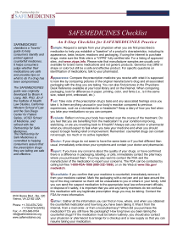S.A.F.E.D.R.U.G. guide
Download your own copy of the SAFEMEDICINES S.A.F.E.D.R.U.G. guide in English.
This eight-step checklist will help you judge whether your medications are safe and provides tips on what to do if you think a drug has been compromised.
Sample: Request a sample from your physician when you are first prescribed a medication to help you establish a “baseline” of a product’s characteristics, including its appearance, taste, texture, reactions and packaging. If using the Internet to purchase drugs, make sure the Web site is a VIPPS fully certified site. Please note that manufacturer samples are usually only available for brand name medications and not generic products. Generics may differ in shape or color but still be a safe and effective product. For specific questions on identification of medications, talk to your pharmacist.
Appearance: Compare the prescription medicine you receive with what it is supposed to look like by taking pictures of the original manufacturer’s drug and all associated packaging with the drug you are taking. You can also find pictures in the Physicians Desk Reference. When comparing packaging, look for differences in paper, printing, color, and fonts (i.e. is it the same size, raised print, embossed, etc.).
Feel: Take note of the prescription drug’s taste and any associated feelings once you take it. Is there anything unusual in your body’s reaction compared to previous experiences, such as a stomach ache or headache? Keep a diary of how you feel when you take your medications so you can compare.
Evaluate: Reflect on how your body has reacted over the course of the treatment. Do you feel that you are benefiting from the medication? Is your condition improving, stabilizing, or are you reverting back to ill health? Always ask your doctor or pharmacist what you should expect to feel when you take your medicine and when you should expect to begin feeling relief or improvement. Remember: counterfeit drugs can contain not enough, too much or no active ingredient.
Doctor: If your drugs do not seem to have the same taste or if you feel different than usual, immediately write down your symptoms and contact your doctor and pharmacist.
Report: If you have any concerns about the quality of your drugs, or have confirmed there is a difference in packaging, labeling, or pills, immediately contact the pharmacy where you purchased them. You may also want to contact the FDA and the manufacturer of the medication to report your concerns. The FDA can be contacted by calling toll-free 1-800-FDA-1088 (800-332-1088), or on the Web at www.fda.gov/medwatch.
Unavailable: If you confirm that your medicine is counterfeit, immediately remove it from your medicine cabinet. Mark it with a red pen and put tape around the top of the drug container so that it will be unavailable to you or others in your family. Until you can send the suspect medication to the appropriate local law enforcement officials, or dispose of it safely, it is important that you and any family members do not confuse this medication with any legitimate prescription drugs you may be taking. Contact the FDA for more information.
Gather: Gather all the information you can find on how, where and when you obtained the counterfeit medication and how long you have been taking it. Was it from the Internet, from a mail order, or from a local pharmacy? When did you purchase the medication? Do you still have the packaging? How long have you been taking the counterfeit drugs? If the medication must be taken routinely, you should also contact your physician or pharmacist to arrange for a checkup and a new supply so that you can resume taking your medication.
Download your own copy of the SAFEMEDICINES S.A.F.E.D.R.U.G. guide in English.
